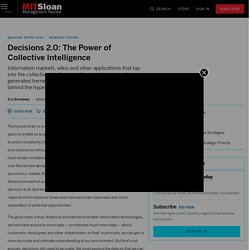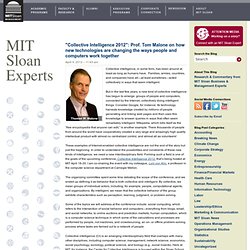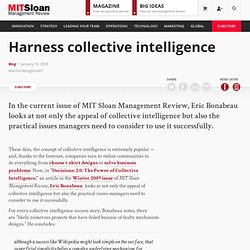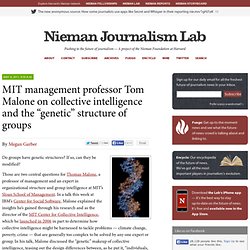

Génome des Systèmes d'Intelligence Collective. CCIwp2009-01.pdf (Objet application/pdf) Programming Collective Intelligence About me and why I read this book I've been programming professionally for ~7.5 years, mainly business applications and reporting, so I already have quite some love for data.

While I haven't used math much in my day jobs, I liked (and was good at) it in high school, including taking extra classes - so I have learned basic statistics. Refreshing and advancing my data analytics skills is one of my goals this year, and reading this book was part of the plan. About the book The book introduces lots of algorithms that can be used to gain new insight into any kind of data one might come across. Each of the algorithms is illustrated with real world application examples, and examples where applying them doesn't make sense are brought too. In addition to the well written, gradual introduction, the book has a concise algorithm reference at the end, so when one needs a quick refresher, there is no need to wade through the lengthy tutorials.
The Collective Intelligence Genome. Topics Social Business Social business research and more recent thought leadership explore the challenges and opportunities presented by social media.

More in this series. Decisions 2.0: The Power of Collective Intelligence. 1.

A.P. McAfee, “Enterprise 2.0: The Dawn of Emergent Collaboration,” MIT Sloan Management Review 47, no. 3 (Spring 2006): 21-28; and S. Cook, “The Contribution Revolution: Letting Volunteers Build Your Business,” Harvard Business Review 86 (October 2008): 60-69. 2. J. Peter Gloor, Research Scientist, MIT 03-19-09 Interview Transcription. Copyright 2010 Betsey Merkel and I-Open.

Creative Commons 3.0Attribution-Noncommercial-No Derivative Works. Institute for Open EconomicNetworks (I-Open) 4415 Euclid Ave 3rd Fl Cleveland, Ohio 44103 USA about being all members of a swarm and these COINS – theseCollaborative Innovation Networks – for me, they are the mainbuilding blocks of those self-organizing groups of people that I call theswarms. I have stumbled on this idea of the swarm by chance when Iwas in Paris with my children and we were looking for restaurantsand on the first day we ended up on top of Monte Martre, which is theplace where all the tourists go so what we did at that time was we didnot follow the swarm we followed the crowd.
Programing the Global Brain. A taxonomy of collective intelligence - Handbook of Collective Intelligence. From Handbook of Collective Intelligence One effort to create a taxonomy of collective intelligence is underway in the MIT Center for Collective Intelligence as part of the Handbook for Collective Intelligence project.
So far, this project has included three “generations” of taxonomies. Home - Climate CoLab. Collective Intelligence 2012. Deliberatorium-intro.pdf (Objet application/pdf) "Collective Intelligence 2012": Prof. Tom Malone on how new technologies are changing the ways people and computers work together. Collective intelligence, in some form, has been around at least as long as humans have.

Families, armies, countries, and companies have all—at least sometimes—acted collectively in ways that seem intelligent. But in the last few years, a new kind of collective intelligence has begun to emerge: groups of people and computers, connected by the Internet, collectively doing intelligent things. Consider Google, for instance. Its technology harvests knowledge created by millions of people generating and linking web pages and then uses this knowledge to answer queries in ways that often seem remarkably intelligent. Wikipedia, which bills itself as the “free encyclopedia that anyone can edit,” is another example. Main Page - Handbook of Collective Intelligence. Mark Klein. Center for Collective Intelligence. Handbook of Collective Intelligence Edited by Thomas W.

Malone and Michael S. Bernstein. Malone.pdf (application/pdf-Objekt) Jean Lievens: Thomas Malone on Collective Intelligence — You Have to Give Away Old Power In Order to Gain New Power. Jean Lievens Thomas Malone, director of the MIT Center for Collective Intelligence, is one of the leading thinkers in the realm of anticipating how new technologies will transform the way work is done and leaders lead.

His 2004 book, The Future of Work: How the New Order of Business Will Shape Your Organization, Your Management Style, and Your Life,helped thousands of executives and would-be executives see their organizations, and themselves, in startling new ways. As a result, many organizations are becoming more collaborative and democratic. Now, Malone is exploring how social business, data analytics and cognitive computing will transform organizations once again. Here, he talks about the revolution that is coming. Harness collective intelligence. In the current issue of MIT Sloan Management Review, Eric Bonabeau looks at not only the appeal of collective intelligence but also the practical issues managers need to consider to use it successfully.

These days, the concept of collective intelligence is extremely popular — and, thanks to the Internet, companies turn to online communities to do everything from choose t-shirt designs to solve business problems. Now, in “Decisions: 2.0: The Power of Collective Intelligence,” an article in the Winter 2009 issue of MIT Sloan Management Review, Eric Bonabeau looks at not only the appeal of collective intelligence but also the practical issues managers need to consider to use it successfully.
For every collective intelligence success story, Bonabeau notes, there are ”likely numerous projects that have failed because of faulty mechanism designs.” He concludes: MIT Unravels the Secrets Behind Collective Intelligence – Hint: IQ Not So Important. What makes a group able to succeed at large number of different tasks?

Women, sharing, and sensitivity. When it comes to a successful group, the easiest way to ensure victory may be placing women on the team. The emerging science of 'collective intelligence' — and the rise of the global brain. Evidence for a Collective Intelligence Factor in the Performance of Human Groups. MIT management professor Tom Malone on collective intelligence and the “genetic” structure of groups. Do groups have genetic structures?

If so, can they be modified? Why Women Make Teams Smarter. Thomas Malone on Building Smarter Teams. What if you could measure the intelligence of a group? What if you could predict which committees, assigned to design a horse, would end up with a camel, versus which would develop a thoroughbred—or a racecar? A Billion Brains are Better Than One. Collective Intelligence. It's also possible for groups of people to work together in ways that seem pretty stupid, and I think collective stupidity is just as possible as collective intelligence. Part of what I want to understand and part of what the people I'm working with want to understand is what are the conditions that lead to collective intelligence rather than collective stupidity. But in whatever form, either intelligence or stupidity, this collective behavior has existed for a long time.
What's new, though, is a new kind of collective intelligence enabled by the Internet. Think of Google, for instance, where millions of people all over the world create web pages, and link those web pages to each other. Then all that knowledge is harvested by the Google technology so that when you type a question in the Google search bar the answers you get often seem amazingly intelligent, at least by some definition of the word "intelligence. " All Together Now (or, Can Collective Intelligence Save the Planet?) MIT Sloan School professor Thomas Malone addresses the mental models that impede management progress, the role of collective intelligence in solving climate problems, and his view of how wrong people are about what business is for.
Even before launching the MIT Center for Collective Intelligence, Thomas Malone was trying to imagine how work could one day be done differently. A professor at the MIT Sloan School of Management, he was a founding co-director of the Initiative on Inventing the Organizations of the 21st Century, and in general has continuously explored how “to help society take advantage of the opportunities for organizing itself in new and better ways made possible by technology.”
Some of those ways offer interesting paths to sustainability—but the paths are to sustainability as Malone defines it, which doesn’t mean a world in which everything is built to last. “It’s often the case that good things are sustainable, but sometimes things are sustainable but not good,” he says. Tom Malone - Program for the Future Dec. 8. MIT Center for Collective Intelligence. Decisions 2.0: The Power of Collective Intelligence. Information markets, wikis and other applications that tap into the collective intelligence of groups have recently generated tremendous interest. But what”s the reality behind the hype? Image courtesy of “American Idol.” The human brain is a magnificent instrument that has evolved over thousands of years to enable us to prosper in an impressive range of conditions. Collective Intelligence. Thursday, Oct. 4, 2007 5 - 7 p.m. Bartos Theater Abstract A conversation about the theory and practice of collective intelligence, with emphasis on Wikipedia, other instances of aggregated intellectual work and on recent innovative applications in business.
Speakers Karim R. Lakhani is an assistant professor in the Technology and Operations Management Unit at the Harvard Business School where he studies distributed innovation systems and the movement of innovative activity to the edges of organizations and into communities. Thomas W. Alex (Sandy) Pentland is the Toshiba Professor of Media Arts and Sciences at MIT where he directs the Media Lab's Human Dynamics research program. Summary By Greg Peverill-Conti [this is an edited summary, not a verbatim transcript]